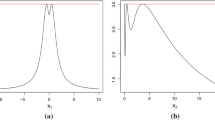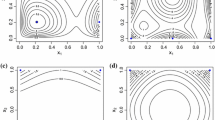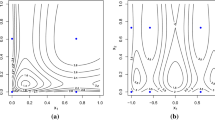Abstract
In the general linear model consider the designing problem for the Gauß-Markov estimator or for the least squares estimator when the observations are correlated. Determinant formulas are proved being useful for theD-criterion. They allow, for example, a (nearly) elementary proof and a generalization of recent results for an important linear model with multiple response. In the second part of the paper the determinant formulas are used for deriving lower bounds for the efficiency of a design. These bounds are applied in examples for tridiagonal covariance matrices. For these examples maximin designs are determined.
Similar content being viewed by others
References
Bischoff, W. (1992). On exactD-optimal designs for regression models with correlated observations,Ann. Inst. Statist. Math.,44, 229–238.
Bischoff, W. (1993a). On the efficiency of designs with respect to theD-criterion when the observations are correlated, Habilitationsschrift, University of Karlsruhe, Germany.
Bischoff, W. (1993b). OnD-optimal designs for linear models under correlated observations with an application to a linear model with multiple response,J. Statist. Plann. Inference,37, 69–80.
Bischoff, W. (1994). Lower bounds for the efficiency of designs with respect to theD-criterion when the observations are correlated (submitted).
Bischoff, W., Cremers, H. and Fieger, W. (1987). Optimal regression models in electrocardiography,Innovation et Technologie en Biologie et Medicine,8, 24–34.
Bischoff, W., Cremers, H. and Fieger, W. (1990). Optimal designs in electrocardiography with non-constant variances,Z. Angew. Math. Mech.,70, 731–733.
Budde, M. (1984). Optimale Zweifachblockpläne bei seriell korrelierten Fehlern,Metrika,31, 203–213.
Eaton, M. L. (1983).Multivariate Statistics (A Vector Space Approach), Wiley, New York.
Halmos, P. (1950). Normal dilations and extensions of operators,Summa Brasiliensis Mathematicae,2, 125–134.
Kiefer, J. and Wynn, H. P. (1981). Optimum balanced block and latin square designs for correlated observations,Ann. Statist.,9, 737–757.
Kiefer, J. and Wynn, H. P. (1983). Autocorrelation-robust design of experiments,Scientific Inference and Data Analysis and Robustness, Academic Press, New York.
Kiefer, J. and Wynn, H. P. (1984). Optimum and minimax exact treatment designs for one-dimensional autoregressive error processes,Ann. Statist.,12, 414–450.
Krafft, O. and Schaefer, M. (1992).D-optimal designs for a multivariate regression model,J. Multivariate Anal.,42, 130–140.
Kruskal, W. (1968). When are Gauss-Markov and least squares estimators identical? A coordinate-free approach,Ann. Math. Statist.,39, 70–75.
Kunert, J. and Martin, R. J. (1987). On the optimality of finite Williams II(a) designs,Ann. Statist.,15, 1604–1628.
Marshall, A. W. and Olkin, I. (1979).Inequalities: Theory of Majorization and Its Applications, Academic Press, New York.
Pukelsheim, F. (1993).Optimal Design of Experiments, Wiley, New York.
Pukelsheim, F. and Rieder, S. (1992). Efficient rounding of approximate designs,Biometrika,79, 763–770.
Rao, C. R. (1967). Least squares theory using an estimated dispersion matrix and its applications to measurement of signals,Proceedings of the Fifth Berkeley Symposium on Mathematical Statistics and Probability, Vol. 1 (eds. L. M. LeCam and J. Neyman), 355–372, University of California Press, Berkeley.
Zyskind, G. (1967). On canonical forms non-negative covariance matrices and best and simple least squares linear estimators in linear models,Ann. Math. Statist.,38, 1092–1109.
Author information
Authors and Affiliations
Additional information
Parts of the paper are based on a part of the author's Habilitationsschrift Bischoff (1993a).
About this article
Cite this article
Bischoff, W. Determinant formulas with applications to designing when the observations are correlated. Ann Inst Stat Math 47, 385–399 (1995). https://doi.org/10.1007/BF00773469
Received:
Revised:
Issue Date:
DOI: https://doi.org/10.1007/BF00773469




